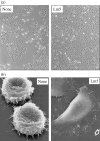Laminin-5 (laminin-332): Unique biological activity and role in tumor growth and invasion
- PMID: 16441418
- PMCID: PMC11159065
- DOI: 10.1111/j.1349-7006.2006.00150.x
Laminin-5 (laminin-332): Unique biological activity and role in tumor growth and invasion
Abstract
The development and progression of tumor cells is controlled by their interactions with neighboring host cells and a variety of microenvironmental factors including extracellular matrix (ECM) molecules, growth factors and proteinases. Cell-adhesive ECM proteins are a prerequisite for growth and migration of many types of cells. Their interactions with integrins and other cell surface receptors induce intracellular signaling that regulates the actin cytoskeleton and gene expression. The basement membrane protein laminin-5 is a notable cell adhesion molecule, which promotes cellular adhesion and migration much more efficiently than other ECM proteins. There is accumulating evidence that laminin-5 is involved in tumor growth and progression. With special reference to laminin-5, this article reviews the regulatory mechanisms of cellular adhesion and migration by ECM molecules and their significance in tumor progression.
Figures






References
-
- Liotta LA, Kohn EC. The microenvironment of the tumour–host interface. Nature 2001; 411: 375–9. - PubMed
-
- Nelson AR, Fingleton B, Rothenberg ML, Matrisian LM. Matrix metalloproteinases: biologic activity and clinical implications. J Clin Oncol 2000; 18: 1135–49. - PubMed
-
- Liotta LA. Tumor invasion and metastases − role of the extracellular matrix: Rhoads Memorial Award lecture. Cancer Res 1986; 46: 1–7. - PubMed
-
- Sato H, Takino T, Okada Y et al. A matrix metalloproteinase expressed on the surface of invasive tumour cells. Nature 1994; 370: 61–5. - PubMed
Publication types
MeSH terms
Substances
LinkOut - more resources
Full Text Sources
Other Literature Sources

